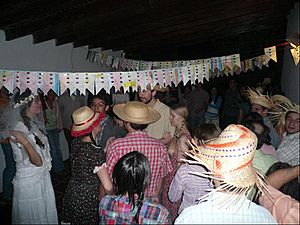Festa Junina facts for kids
Festas Juninas (which means June Festivals) are super fun yearly celebrations in Brazil. They are also called festas de São João because they celebrate the birthday of Saint John the Baptist on June 24th. These festivals are like Brazil's version of European Midsummer parties, but they happen during the southern winter.
The Portuguese brought these traditions to Brazil a long time ago, between 1500 and 1822. People celebrate them all over the country in June. The main party days are around the special Catholic holidays for Saint Anthony, Saint John the Baptist, and Saint Peter.
In Northeastern Brazil, where it can be very dry, these festivals happen when the rainy season ends. It's a chance for people to thank Saint John for the rain! The festivals also celebrate country life. You'll see special clothes, yummy food, and lots of dancing, especially a dance called quadrilha, which is a bit like a square dance.
Contents
Where Did Festas Juninas Come From?
Many parts of the Festas Juninas come from old European Midsummer parties. For example, lighting a big bonfire is a tradition from those times. In Brazil, these celebrations now have a special country feel. The parties often happen in an arraial, which is a big tent with a thatched roof. These tents were used for important parties in old Brazilian country areas.
Because Brazil's weather is different from Europe's, Brazilians use the festival to show thanks for the rain. A huge fire, called a fogueira, is lit during the festival. This comes from a Catholic story. It says that Elizabeth lit a fire on a hill to tell Mary that Saint John the Baptist was born and to ask for her help after childbirth.
Most of these festivals used to be held away from the coast, in the countryside where big farms were. When Portugal still ruled Brazil, cities like Recife in Pernambuco became busy with factories. The king, Dom João, changed rules to help these cities grow. Even though the Festa Junina started in the country, it became much bigger in modern cities.
Today, these celebrations are even larger than those in Europe. Schools often host them, but many cities also have huge parties. In Caruaru, Pernambuco, about 1.5 million people went to the festival in 2011! This earned them a Guinness World Record for the biggest Festa Junina celebration ever.
Fun Traditions and Activities
In Brazil, country farmers, called caipiras, are the main people who keep these traditions alive. Men dress up like farm boys with big straw hats. Women wear pigtails, draw freckles on their faces, paint a gap in their teeth, and wear red-checked dresses.
Dancing at the Festival
The main dance at the festival is the "quadrilha." Many of these dances came from Europe in the 1800s, brought by the Portuguese. The "quadrilha" involves couples dancing together around a pretend wedding. The bride and groom are the most important part of the dance. This dance shows how the land is fertile and can grow crops.
There are different kinds of quadrilha dances. One type is called Cana-Verde. It's a kind of fandango dance that is popular in the south of Brazil. Dancers often make up their moves as they go. Dances involving Bumba Meu Boi are also part of the festival. In this dance, a woman wants to eat an ox's tongue. Her husband kills the ox, which makes the ox's owner sad. Then, a healer comes and brings the ox back to life, and everyone celebrates!
Music of Festas Juninas
A type of music called Forró goes along with these dances. This traditional music mostly uses accordions and triangles. It tells stories about the lives and struggles of the caipiras. The music often talks about saudade, which is a feeling of missing or longing for country farm life. Newer versions of Forró music might also use guitars, fiddles, and drums.
Games for Kids
Many games for children are played at Festas Juninas, especially at school festivals that raise money.
- Pescaria: Kids use a fishing rod to pick up cans or paper fish from a box.
- Corrida do saci: Children hop on one leg to the end of a line in a race. They are pretending to be the saci perere, a character from Brazilian folklore.
- Corrida de três pés: This is a three-legged race. Two friends tie one of their legs together and race against others.
- Jogo de argolas: This is Ring Toss. Players throw rings onto bottles, trying to land them around the neck.
- Tiro ao Alvo: This is Dart toss. Players throw darts at a target to get the most points.
Winners of these games usually get small prizes, like toys or food.
Festas Juninas Today
Today, São João parties are super popular in Brazil's biggest cities. When a festival celebrating country life happens in a city, it can sometimes show how people think about caipiras. Some people in big cities might think country farmers are not as educated or good at talking to others. This can sometimes be seen in funny drawings of caipiras taught to kids in schools. They might be told to use wrong grammar or act silly during the festival.
Also, some people worry that the festival is changing too much. They feel it's becoming more like Carnival, with huge concerts in big cities for Brazilians and tourists. This means there's less focus on the religious meaning of the festival.



